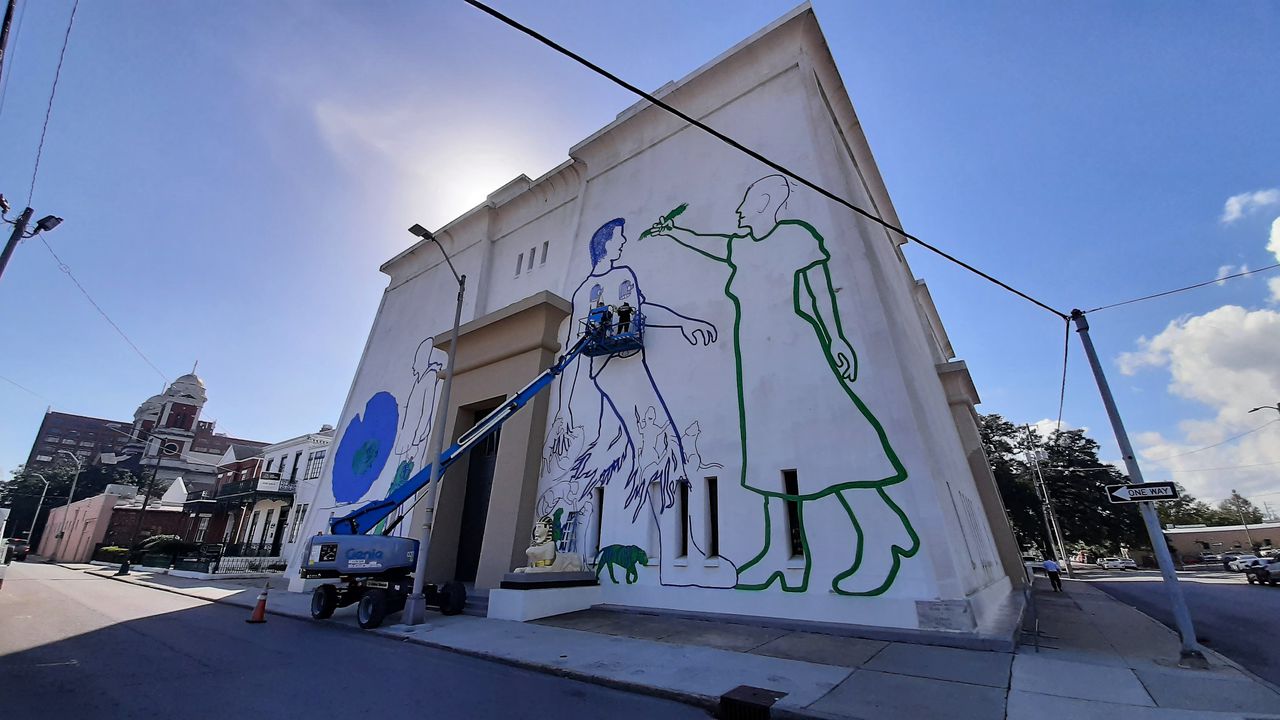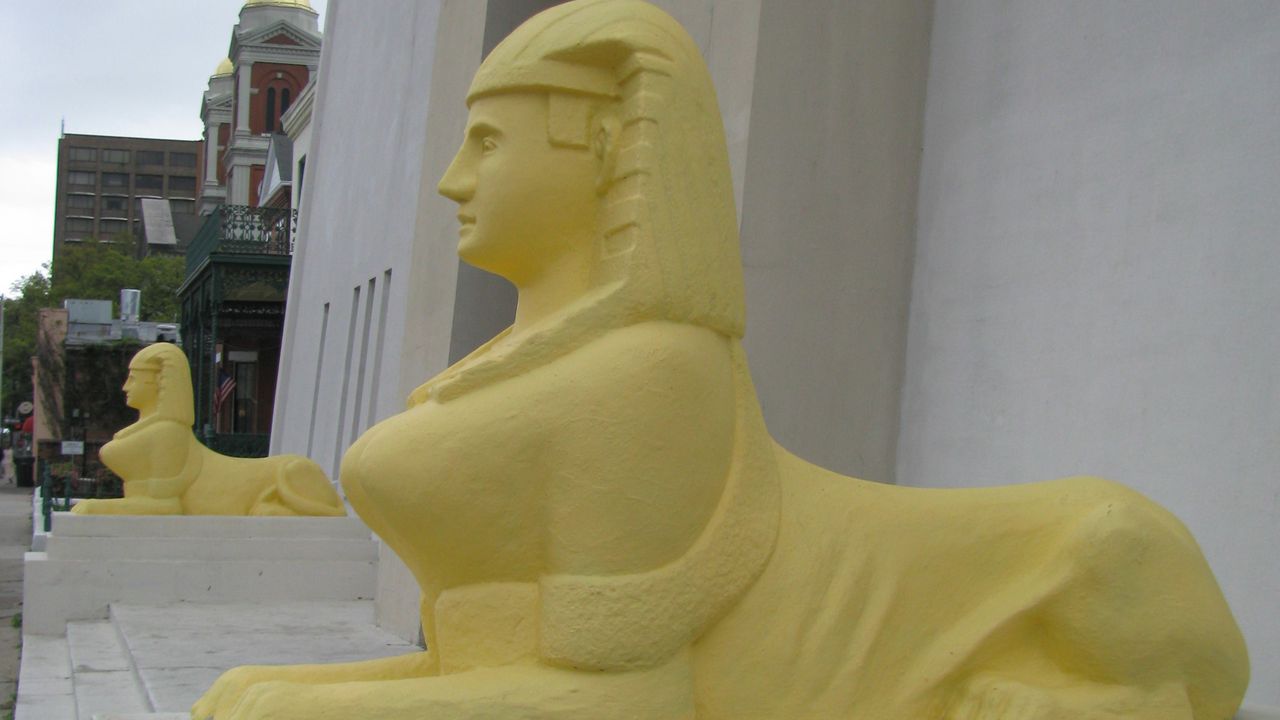This Alabama landmark could be yours for $7 million, sphinxes and all
It could be the most head-turning building in all of Alabama, and it could be yours – sphinxes and all – for an asking price of $7 million.
The Temple Downtown, as the structure has been known in recent years, sits a block from Mobile’s Cathedral Square and it truly is hard to miss. Built in 1921-22 for the Ancient and Accepted Scottish Rite of Freemasonry, it’s four stories tall with sloping, slab-sided walls evocative of ancient Egyptian pylons or even the pyramids. Two horse-sized sphinxes flank a main entrance worthy of a small fort or castle, and a couple of obelisks rise from the rooftop.
Surviving buildings in the Egyptian Revival style are rare anywhere, and the Temple is certainly unique in Mobile. It’s also on the National Register of Historic Places. Its provenance includes the fact that it was designed by George Bigelow Rogers, an architect responsible for numerous Mobile landmarks of the early 20th century.
Bryan J. Olson, an agent with a background in architecture and design who has experience renovating historic properties, is handling the listing for Roberts Brothers TREC. He ran down some of the building’s many features: A ground-floor ballroom with a capacity of 1,000 people, with stage and commercial kitchen. Office space above that could be converted into residential space. A full basement suitable for conversion into a speakeasy-type club. A “vast” fourth-floor room decorated for the Scottish Rite’s ceremonies, with velvet-draped murals of Egypt. An expansive rooftop gathering space flanked by those obelisks, designed in part to camouflage chimneys. (Many of these features can be seen in a photo gallery at robertsbrothersstudio.com.)
The familiar sphinxes in front of the Scottish Rite Temple at Claiborne and St. Francis streets have enjoyed many paint schemes over the years. Here they’re shown in a fresh coat of yellow. (Mark R. Kent/Press-Register)Mark Kent/Press-Register
The building is heavily famed in steel and concrete, with a six-foot-thick ceiling, Olson said. He said tax records reckon the interior space at about 58,000 square feet, though he said he’s not sure that’s perfectly accurate “because there are hidden passages in there.”
“The dream client would be someone who understands the historicalness of the building, who wants to maintain that historic fabric,” he said. “Someone who’s willing to develop it in a multi-use manner. A potential event space, restaurants, maybe a boutique hotel. It could be a mini-city within those walls.”
That vision has been there for more than a quarter-century, said Scott Gonzalez, who bought the property around 1995. About 2019, he said, he partnered with a co-owner, Frank Ellis.
For Gonzalez, the Temple story begins with the Three Georges candy store, a business that was founded in 1917 and stayed in family ownership until 1992, when Gonzalez bought it and the historic Dauphin Street building that houses it from Euple Pappas.
Like many American downtowns, Mobile’s had suffered through blight in the 1970s and 1980s as retailers moved away, chasing customers and they sprawled out into suburbs. In the early ‘90s, downtown Mobile was just beginning so show the first tender shoots of revitalization. Gonzalez said he was among those who thought better days might be ahead and wanted to invest. He approached Pappas about leasing the Temple, only for her to offer a sale price that he found irresistible.
He won’t say exactly what that price was, but it reflected the fact that downtown Mobile wasn’t at its best. “It was really, really cheap, let’s put it that way,” he said. “It was what I paid for a house in Oakleigh. It was really, way, way down there.”
Of course, the property came with some challenges. “She always said, with me she found her a sucker,” he said. “Candy humor, right?”
Gonzalez said that the Scottish Rite had been grandfathered into fire code changes, but as the new owner he had to face a century’s worth of accrued regulations. Putting the full building into commercial service would have required some massively expensive upgrades, so he kept the upper floors shuttered. “At that point I kind of looked at it as a one-story building with a great façade,” he said.
From the mid-’90s to the present, the Temple’s ground floor saw intermittent use as an event space. While that was far short of the potential one might imagine for it, positive things were happening: Over that quarter-century, revitalization took root along Dauphin and Conti streets, blossomed along Royal Street and rocketed back down once-desolate St. Louis Street. Large-scale properties, such as the 18-story Merchants Bank building off Bienville Square, have attracted investors who’ve renovated them into mixed-use developments.
Gonzalez said his approach has been to “keep the roof from leaking and keep the air conditioning going” so that the Temple didn’t deteriorate. He reckons that a full-on renovation might cost $15 million to $25 million – but that the time has come when those numbers might make sense for an investor, given the progress that downtown Mobile has made.
Olson said the building is eligible for tax credits and grants that could support a renovation.

Mobile’s Temple Downtown has been something of a blank canvas for the last 30 years; this image from December 2022 shows it being used as a slate for a temporary tape art mural in a project facilitated by the Mobile Arts Council. Now it’s for sale, raising the potential it could see development as a commercial mixed-use space.Lawrence Specker | [email protected]
Gonzalez said he always knew that realizing the Temple’s potential was a tall order, but that he bought it partly as an investment, banking on the possibility that downtown would overcome its doldrums.
“It’s been a really interesting ride to have that building and preserve it to the extent that I can,” said Gonzalez. “But now that downtown is coming back, and I’m getting close to retirement age, I’m like, okay, it’s time to pass that baton along and see what really can be done with that building.”
“I think it’s a great opportunity, and a great opportunity for Mobile, for it to be a showplace,” he said.
It’s certainly a rarity.
“It’s absolutely one of the most interesting Egyptian Revival buildings in the country,” said Olson. “I don’t think, if you were to Google that, Egyptian Revival, much would pop up.”
